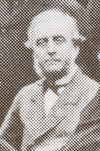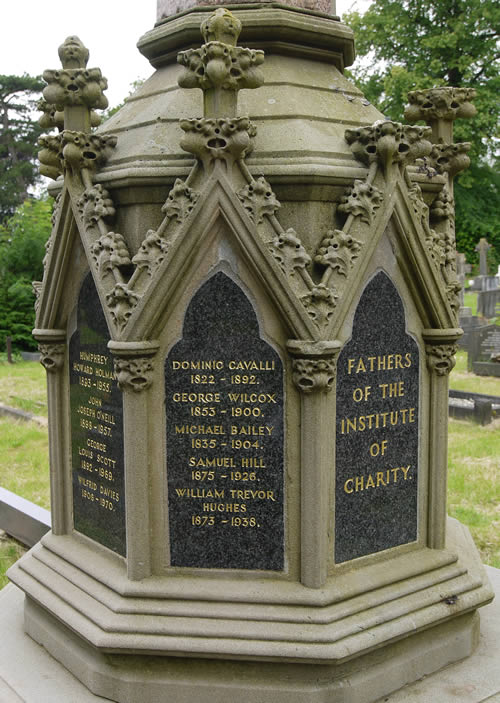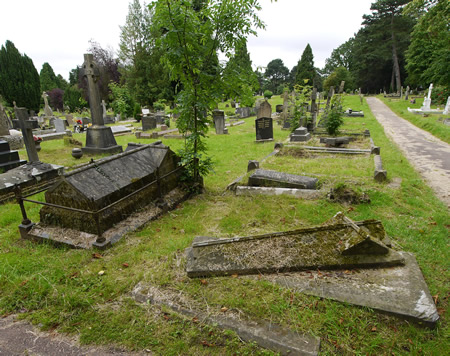St Woolos Cemetery - The Haunted Holy Ground
From the book "The Haunted Holy Ground" by Mike Buckingham and Richard Frame published in 1988.
And Henceforth .... Hygiene
By Mike Buckingham and Richard Frame
First published 1988
© Mike Buckingham and Richard Frame 2012
The dead can be presumed to have no further interest in mortal gain but the same can never be said for those they leave behind. The early story of the cemetery is one of a conflict of interests sometimes between religious groups, but sometimes over nothing more elevated than earthly spoils.
The original idea of cemeteries, health considerations apart, was that they should be places where the living can quietly commune with the dead in dignified surroundings. No more should stinking corpses buried in only inches of soil offend the senses of the living. An Act introduced by Lord Palmerston’s government in 1850 had imposed strict rules on the way burial boards must conduct their business.
Not only was the disposal of the dead to be conducted in a thoroughly hygienic fashion but from that time on records were to be kept. Prior to 1854 there were no public cemeteries in Britain although a private cemetery at Kensal Green, London, opened in 1837 followed shortly by the most famous of all at Highgate two years later.
Newport’s was the first public cemetery to open and if for no other reason than this deserves the penning of a historical footnote.
When in February, 1854 the first 14 acre site now contained within the present cemetery was bought from Lord Tredegar and initially shared out between the established church and dissenters all seemed ecumenical sweetness and reason.
Such an amicable state of affairs was not to last. The numerous, but at that stage not influential Catholic voice had a secret meeting at St Mary’s Church on Stow Hill where a petition to Lord Palmerston was drawn up complaining that Catholics had not been allocated a parcel of land for the burial of their own dead, despite the clear intention of the Act that this should be so. This snub to the Roman Catholics was not an oversight. The then vicar of St Woolos, also chairman of the burial board, was well aware of the intention of the new Act, but took the view that Catholics could be buried in ground consecrated as each grave was dug, along with dissenters.
There matters might have stood had not the town clerk, Mr Thomas Woollett himself a Roman Catholic, been on the burial board, together with two of his co-religionists.

Thomas Woollett 1872
It was clear that Catholics were not going to take this snub lightly. What was to follow was a wrangle between Catholics and Protestants which, it has to be admitted, did little for the reputation of the town.
In the May of 1853 Mr Dowling, a Catholic, put forward the case for five acres of land being given over to the burial of Roman Catholics at St Woolos cemetery. The chairman of the board, the Rev. Hawkins, was doctrinally opposed to this.
Unfortunately for the reverend gentlemen Catholics were flooding into the town to provide manpower for its industrial expansion. It was inevitable that their demands for burial space would come about.
And this is how it happened. With seeming innocence, a member of the burial board, Mr Llewellyn, asked how other towns dealt with the sensitive problem of the interment of Roman Catholic bodies. Mr Woollett, the town clerk and a Roman Catholic and therefore knowledgeable upon this subject was able to reply that Newport was the first town to which the new Act applied and therefore no precedent had been sent. While the souls of the departed had been served by the rites of the Roman Catholic church, the mortal remains were in a legal limbo.
The gathering of three denominations in a single place of burial with a guaranteed Catholic plot was resisted by the Monmouthshire Merlin, which maintained that Catholics and non-conformists should have their own burial plot within the curtilages of the Anglican burial site but at some distance from those of the established faith.
After a boardroom drama which would have done credit to a modern soap opera the following motion was proposed for discussion at the next meeting of the burial board.
It read: “That a portion of the unconsecreted ground be apportioned for the burial purposes of the Catholic inhabitants of Newport”.
On May 20, 1853 there was a special meeting of the burial board attended by a Mr Samuel Humphrey, son-in-law of Lord Tredegar, who came from London to ensure the Roman Catholics did not win the day. Woollett spoke for the motion, which was seconded by Mr Dowling, who stressed that all eyes were turned towards Newport over the matter of Catholic burials.
“Newport would have the honour of being looked to for its liberal and enlightened views,” he said.
With that the mayor, Mr J. Brown, erupted from his leatherbound seat of office thundering: “This board considers an allotment of a portion of the cemetery for exclusive burial by the Roman Catholics as inexpedient.
“They are being given a privilege not asserted by the established church and one which will be unfair to other denominations of dissenters; and furthermore something which is repugnant to a large proportion of the community.”
So loud was his indignation that his view carried the day and the motion was defeated.
But there were more shots in the Catholic locker. Undeterred by defeat at the burial board meeting their leaders wrote back to Lord Palmerston asking him to enforce the law of the land, which he duly did.
At a meeting of the burial on August 12 a letter from Lord Palmerston was discussed which must have pinned back a few ears. It demanded to know why Newport was not complying with the new legislation.
During a stormy meeting the mayor blurted out: “It was not for the government to allot it (Catholic burial land) neither to dictate to the board.”
Unsatisfactorily from the Catholic point of view the meeting decided merely to note Palmerston’s communication.
Despite the wranglings at the burial board which went on well into October the cemetery had been open since July 1 with the hapless Cooper filling the first plot.
In October Lord Palmerston wrote back to Newport’s burial board insisting that the regulations be complied with. It was perhaps ironic that although Newport had opened the first public cemetery in Britain the town had very shortly afterwards lost its pioneering impetus. By that month both Preston in Lancashire and Taunton in Somerset had not only opened cemeteries but had set aside ground for the burial of Catholics and nonconformists.
To Newport’s Catholics it must have indeed felt that the burial board had set their faces against them.
When four acres were eventually and after much opposition set aside for Catholic burials it was uncleared scrub land originally earmarked for arable, this despite the fact that the rest of the cemetery was being laid out attractively. It was an ungracious and unseemly incident and one which did their corporation little credit even given the sometimes bigoted attitudes of the time.
And it was far, far too much for the volatile Father Cavilli, a Catholic priest in Newport who had been at the forefront of the campaign for Catholic grave spaces.
Unannounced and with cassock flying he turned up at the December meeting of the burial board and demanded that the Catholic plot be cleared so that burials could begin. So persuasive was his rhetoric that opposition to the Catholic case evaporated.

Dominio Cavalli 1822 - 1892
RC D8
By January 10 a four-year-old boy, James Donegan, a Roman Catholic had been laid to rest. He was the one hundred and fifty-forth person to be buried at St Woolos.
For the family little could have compensated for the loss of their son. But if there was a crumb of comfort to be had it was this; the infant had written a small footnote in the history of the town in which he had died, even though far too young to wield a pen for himself.
It is perhaps easy to frown at the insularity of our forefathers, but it is as well to remember they had a close proprietorial interest in the community that they were helping forge. They resented what they saw in a Catholic, and therefore foreign, intrusion.
On the heels of the Roman Catholic victory Newport’s rabbi sought a similar concession for Jews but was rejected. Newport’s burial had gone so far towards accommodating the growing Catholic population, but they could not go as far with the imperfectly integrated non- Christian faith.
Since then, a hundred and thirty years have passed during which time many prejudices have been broken down. Nowadays it is far from unusual to catch the whiff of burning incense accompanying a Hindu burial.
Not only Protestants, noncomformists and Roman Catholics but Moslems and Hindus share the cemetery and Jews have their own little section adjoining the main cemetery.
It is fitting that the leading Roman Catholics who battled so long and hard for the right of Catholics to be buried in their own corner of St Woolos should have their own peaceful resting place there.
Thomas Woollett lays beneath an unostentatious chest tomb; a fitting memorial to a man who fought for Catholic rights in such a dignified manner.

The graves of brothers Thomas and Robert Woollet
RC AB2